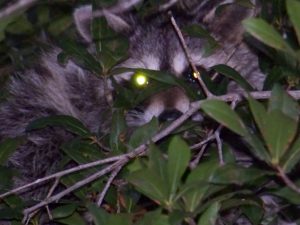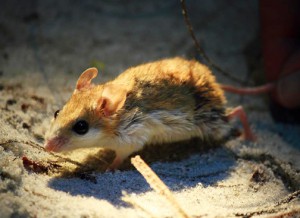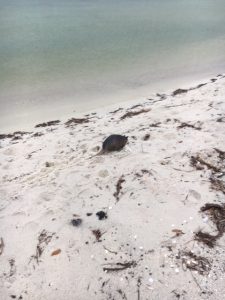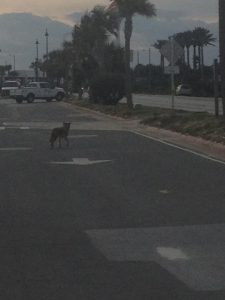You are probably not going to see them… but they are there.
Mammals are fur covered warm blooded creatures. Beaches are hot, dry, sandy places. Just as in the deserts, it would make sense for island mammals to be nocturnal. We know of their existence by their tracks and their scat. Rabbit, raccoon, and armadillo tracks are quite common. Deer, coyote, and beach mice less so. All that said, some are seen at dawn and dusk and it is not unheard of to see them in the middle of the day – especially during the cooler months.
One question that may come up is – “how did they get to an isolated island?” Some scientists have a lot of fun trying to solve that mystery. Some island mammals, like otters, are very good swimmers and would have no problem. Many barrier islands begin as sand spits connected to the mainland – the mammals ventured out into new territory – set up camp – and either over time, or over night in a hurricane – the spit breaks off and the mammals are there. And let’s not forget we built bridges – they know how to use them. Coyotes have been seen walking across the Bob Sikes Bridge from Gulf Breeze.
Another question that comes up – “where are they in the middle of the day?” Most dig, or find, burrows and dens. Just a few inches below the surface it is very cool. Some will find thick hammocks in the maritime forest and “hunker down” for the day.

The sneaky raccoon is an intelligent creature and has learned to live with humans.
Photo: Molly O’Connor
Raccoons
The raccoon (Procyon lotor) is one of the more intelligent and fearless of the beach mammals. Their opportunistic behavior frequently brings them into contact with humans. They will scurry across your lawn at night looking for insects, cat food, garbage, whatever they can find to eat – and outdoor lights do not seem to bother them. There are even videos of them reaching into “dog doors” searching. On the island, their tracks are often found in the marsh areas – where they grab shellfish and are one of the few animals that wash their food before eating it. They usually like to settle into hollow trees during the day. But on the island, it is more likely burrows in the sand.
Their tracks might show the presence of a claw (always hard in soft sand – better chance in wet). The front foot is smaller than the back and they walk with an alternating pattern – usually the front and back foot are close to each other – unless they are running. The front foot is about 2.5”x2.5” – a little round, and the index from the pad to the tip is thinner. The hind foot is about 2.5” wide but closer to 4” long.
The scat is cigar shaped and about 3” long.
Read more:
https://myfwc.com/media/1666/livingwithraccoons.pdf.
Armadillo
Here is an interesting creature. It doesn’t even look like a mammal – not sure what it looks like. But mammals they are. If you find one that has been hit by a car you can see, amongst the armored plating, hairs spaced across the body – they are mammals. It is one that is sometimes seen roaming in the middle of the day. They plunge through the leaf litter and bushes of the maritime forest, making a lot of noise, while searching for insects and grubs and crushing them with their peg-like teeth. They are not from around here – rather from central America – and worked their way into the American southwest and southeast. They probably reached the island via the bridges. They are prolific produces – usually having quadruplets of the same sex. You once found them occasionally in the national seashore – but since Hurricane Ivan, you can find them almost anywhere. One bothersome fact of this animal – they are known to carry leprosy – which can be contacted by eating the animal, or handling it.
Their tracks are one of the most common on the beach. The front foot is about 1.8” long and 1.4” wide. You will see only four toes and claw marks may be seen. The two middle toes are longer. The hind foot has a similar pattern, but you will see five toes and they are about 2.2” long. Most tracks include the tail drag between the foot marks. These are quite common all over the island.
The scat is round-ish and not very long – about 2”.
Read more:
https://edis.ifas.ufl.edu/pdffiles/UW/UW45600.pdf
https://myfwc.com/wildlifehabitats/profiles/mammals/land/armadillo/
https://www.floridamuseum.ufl.edu/science/five-facts-nine-banded-armadillo/.
Coyote
This is an animal that makes people nervous. They are one of the larger mammals on the beach, and they are carnivores. Attacks on pets and children are a concern for many. However, this is rarely the case. Studies show that they are actually very nervous around people and tend to stay at a distance. However, if fed cat food or available garbage, they will lose that fear and problems can occur. Like most island mammals, they are nocturnal, and diet studies have found the bulk of their meals are rodents – which is doing us a favor. But, like raccoons, they are intelligent and opportunistic. If they find an easy meal, like shorebird and turtle eggs – or the chicks and hatchlings – they will take them. It was once thought they were creatures of the American west and migrated into the eastern United States. Some scientists have found coyote remains in the eastern US that predate the ice age – so maybe they are just returning home. There are also reports of humans bringing them here for “fox hunts” – not realizing these were not fox. Either way, they are in all 67 counties of Florida, and on Pensacola Beach. They look similar to dogs – but will be thinner and their tails hang down between their legs when they run. One way to know if they are around is to listen when a siren is going – they tend to howl at these.
Their tracks are very similar to dogs and more people are bringing dogs onto the beach and into natural areas – hard to tell them apart. The pad at the rear of both the front and back paws of the coyote has three lobes, dogs have two on the front foot. In general, dog tracks are more round, coyotes typically are long and not as wide. Characteristic of dog family – the claw marks can be seen. Keep in mind that tracks are distorted in soft sand – best to look in wet sand.
The scat is also characteristic of wild canines – long and thin (like a hot dog) and tapered at each end (like a tamale). Coyote scat is usually 3-8” long and may have the characteristic claw scratching marks some dogs do.
Read more:
https://edis.ifas.ufl.edu/pdffiles/UW/UW44300.pdf.
https://myfwc.com/conservation/you-conserve/wildlife/coyotes/.
https://myfwc.com/wildlifehabitats/profiles/mammals/land/coyote/

The Choctawhatchee Beach Mouse is one of four Florida Panhandle Species classified as endangered or threatened. Beach mice provide important ecological roles promoting the health of our coastal dunes and beaches. Photo provided by Jeff Tabbert
Beach Mouse
Beach mice are like the Loch Ness monster – everyone talks about them, but no one has seen one. Many locals have lived on this beach all of their lives and have never seen one – but they are there – and they are protected. The deal with protection is that these are isolated populations on each island. With no chance to mix genes, they have become “unique” and found no where else. There are four species in the state listed as endangered – including the nearby Perdido Key Beach Mouse and the Choctawhatchee Beach Mouse. It is believed the subspecies found on Pensacola Beach is the Santa Rosa Beach Mouse and is not listed as endangered – but is a species of concern (see list in link below). These little guys dig multiple burrows throughout the dune field but prefer those that are more open and have plenty of sea oats. They emerge at night feeding on a variety of seeds, fruits, and even insects – but sea oats are their favorite. It has been suggested they play an important role of dispersing these seeds. The introduction of new predators, and human development, have put these guys at high risk of extinction.
As you can imagine, the tracks are tiny. They are round in shape and show claw marks.
Read more:
https://edis.ifas.ufl.edu/pdffiles/UW/UW17300.pdf.
https://myfwc.com/media/1945/threatend-endangered-species.pdf.
- St. Joe Red Tide Claiming Terrapins - December 15, 2025
- The 2025 Snake Watch Report for the Pensacola Bay Area - December 15, 2025
- Rattlesnakes on Our Barrier Islands; Part 2 – Prey Selection - December 15, 2025


